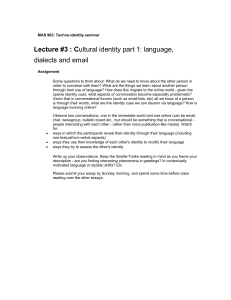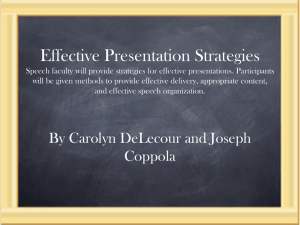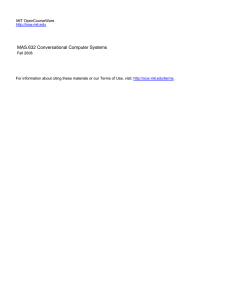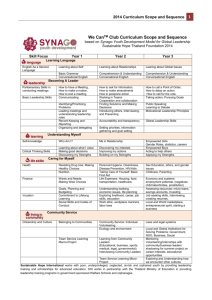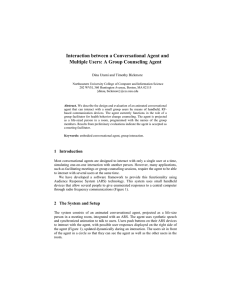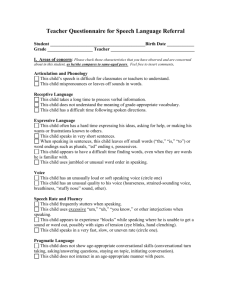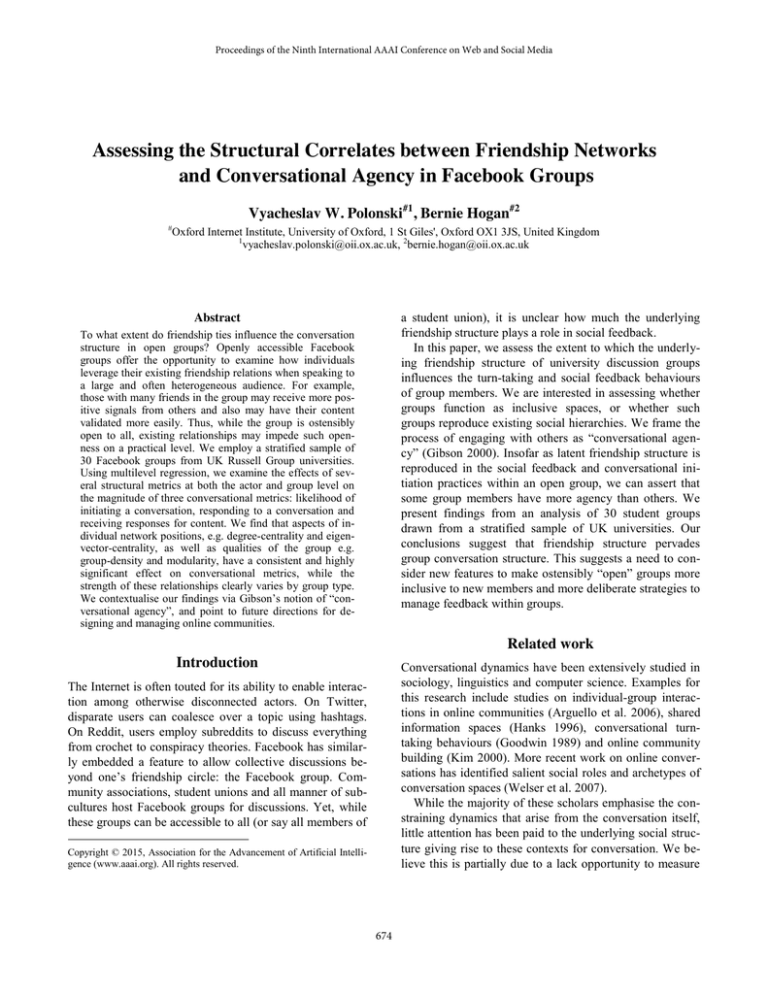
Proceedings of the Ninth International AAAI Conference on Web and Social Media
Assessing the Structural Correlates between Friendship Networks
and Conversational Agency in Facebook Groups
Vyacheslav W. Polonski#1, Bernie Hogan#2
#
Oxford Internet Institute, University of Oxford, 1 St Giles', Oxford OX1 3JS, United Kingdom
1
vyacheslav.polonski@oii.ox.ac.uk, 2bernie.hogan@oii.ox.ac.uk
a student union), it is unclear how much the underlying
friendship structure plays a role in social feedback.
In this paper, we assess the extent to which the underlying friendship structure of university discussion groups
influences the turn-taking and social feedback behaviours
of group members. We are interested in assessing whether
groups function as inclusive spaces, or whether such
groups reproduce existing social hierarchies. We frame the
process of engaging with others as “conversational agency” (Gibson 2000). Insofar as latent friendship structure is
reproduced in the social feedback and conversational initiation practices within an open group, we can assert that
some group members have more agency than others. We
present findings from an analysis of 30 student groups
drawn from a stratified sample of UK universities. Our
conclusions suggest that friendship structure pervades
group conversation structure. This suggests a need to consider new features to make ostensibly “open” groups more
inclusive to new members and more deliberate strategies to
manage feedback within groups.
Abstract
To what extent do friendship ties influence the conversation
structure in open groups? Openly accessible Facebook
groups offer the opportunity to examine how individuals
leverage their existing friendship relations when speaking to
a large and often heterogeneous audience. For example,
those with many friends in the group may receive more positive signals from others and also may have their content
validated more easily. Thus, while the group is ostensibly
open to all, existing relationships may impede such openness on a practical level. We employ a stratified sample of
30 Facebook groups from UK Russell Group universities.
Using multilevel regression, we examine the effects of several structural metrics at both the actor and group level on
the magnitude of three conversational metrics: likelihood of
initiating a conversation, responding to a conversation and
receiving responses for content. We find that aspects of individual network positions, e.g. degree-centrality and eigenvector-centrality, as well as qualities of the group e.g.
group-density and modularity, have a consistent and highly
significant effect on conversational metrics, while the
strength of these relationships clearly varies by group type.
We contextualise our findings via Gibson’s notion of “conversational agency”, and point to future directions for designing and managing online communities.
Related work
Introduction
Conversational dynamics have been extensively studied in
sociology, linguistics and computer science. Examples for
this research include studies on individual-group interactions in online communities (Arguello et al. 2006), shared
information spaces (Hanks 1996), conversational turntaking behaviours (Goodwin 1989) and online community
building (Kim 2000). More recent work on online conversations has identified salient social roles and archetypes of
conversation spaces (Welser et al. 2007).
While the majority of these scholars emphasise the constraining dynamics that arise from the conversation itself,
little attention has been paid to the underlying social structure giving rise to these contexts for conversation. We believe this is partially due to a lack opportunity to measure
The Internet is often touted for its ability to enable interaction among otherwise disconnected actors. On Twitter,
disparate users can coalesce over a topic using hashtags.
On Reddit, users employ subreddits to discuss everything
from crochet to conspiracy theories. Facebook has similarly embedded a feature to allow collective discussions beyond one’s friendship circle: the Facebook group. Community associations, student unions and all manner of subcultures host Facebook groups for discussions. Yet, while
these groups can be accessible to all (or say all members of
Copyright © 2015, Association for the Advancement of Artificial Intelligence (www.aaai.org). All rights reserved.
674
the underlying social structure. Neither message boards,
usenet groups, nor subreddits expose friendship relations.
Instead, conversations are taken to stand-in for this underlying network (Gruzd & Haythornthwaite 2013). By examining the shared friendship structure of group members on
Facebook, we have a novel opportunity to disentangle conversational networks and social networks. This enables us
to explore conversational agency, or the extent to which
certain group members feel more or less constrained in
their capacity to submit content and receive feedback.
cases for analysis to those group members who have been
active at least once (i.e. made at least one post, comment or
“like” within the group). Our final sample size thus consists of 2,148 Facebook users from 30 Facebook groups.
Conversational agency manifests itself when actors
speak up, respond to fellow members, or articulate their
opinions and ideas to the group (Gibson 2000). Thus, we
measured conversational agency in three ways: initiating
posts, sending comments and likes to existing posts (conversational out-degree) and receiving likes and comments
(conversational in-degree). On average, group members
initiated 2.47 wall-posts, contributed 2.41 comments and
“likes” (conversational out-degree) and received 2.64 responses (conversational in-degree) as reported in Table 1.
Methods
To test the effects of relational structure on conversational
agency, we employ a stratified sample of Facebook groups
from UK Russell-Group universities – a large association
of 24 British universities with a student base of 549,460.
First, using an ordered list of Russell Group universities,
we have randomly selected one university from each bin of
approximately 110,000 students. Second, for each of the
five sampled institutions, we have collected an exhaustive
list of all open Facebook groups associated with these universities, and filtered it by membership numbers to retain
only groups with 50<m<1,000 members.1 Third, since
some of these groups had few active members, we have
randomly sampled six groups per university from the list,
generating a total sample of 30 Facebook groups, which
differ in their sizes, social contexts, topics and the types of
individuals they attract.
For each of the groups we downloaded the social graph
of the group. Prior to the introduction of Facebook’s
OpenGraph 2.0 protocol, a group member could access the
friendship structure shared between group members, but
not the friends of group members outside of that group. To
comply with our University’s ethical review board and
good practice, the researchers joined groups with the explicit permission of the group owner and announced the
project to the group. All identifying data about the group
members has been scrubbed from the dataset. Group conversational and friendship data was downloaded using the
Facebook API-based Netvizz application (Rieder 2013).
Our sample resulted in 30 groups with a total of 10,820
group members and 67,555 friendship ties between them.
While friendship relationships form undirected networks,
conversational activity in Facebook groups (i.e. wall-posts,
likes and comments) can be captured in weighted directed
networks where an arc represents an interaction between
two users with a weight equal to the number of replies
from one user to another. We calculate network statistics
for the entire friend network structure, and then filter the
Analysis
The 30 sampled Facebook groups span a variety of interests and social contexts from music societies to sport clubs
and LGBT groups. Groups vary notably in participation,
with a minimum of 9.4% of members participating to a
max of 64.5%. We provide further descriptive statistics in
Table 1. In addition to gender and membership age, we
present a number of statistics on the network structure of
the group’s friendship network. One group was highly
fragmented with 462 distinct components, while most have
a smaller number of distinct components. We assessed the
modularity of partitions found using the Louvain method
for community detection (Blondel et al. 2008). Other statistics are calculated in Gephi. On average, groups were substantially clustered with an average modularity of 0.43. As
a general rule, modularity ought to be greater than 0.3 to
suggest that the separate clusters represent truly distinct
subgroups. The average degree across all actors is 8.55,
whereas the average degree for active group members is
much higher at 23.47 (min 0, max 397). The average clustering coefficient for active group members is 0.33, which
implies that one third of potential triads are closed.
Table 1: Descriptive Statistics
Variable
Number of posts
Conv. in-degree
Conv. out-degree
Gender (male)
Membership age
Degree-centrality
Eigenvector-centr.
Clustering coeff.
Components
Group modularity
Group density
Group size
% active members
1
Preliminary analysis suggested that groups with less than 50 members
tend to be informal or unstable. When groups are larger than 1000, we
cannot reliably retrieve network data from Facebook.
675
Mean
2.47
2.64
2.41
0.57
9.82
23.47
0.21
0.33
60.33
0.43
0.06
405.69
0.33
S.D.
7.26
7.21
3.23
0.50
3.74
33.58
0.23
0.25
97.40
0.11
0.05
267.84
0.18
Min
0
0
0
0
0
0
0
0
1
0.18
0.01
63
0.09
Max
111
134
34
1
20
397
1
1
462
0.79
0.23
997
0.64
Investigating the bivariate correlations, we see that the 3
conversational measures are moderately related among one
another with correlation coefficients ranging from 0.43 to
0.55 (see Table 2). One explanation for these correlations
is that actors, who are actively posting links on the group
wall, are also more likely to receive a response, and engage
with the group using comments and “likes”. Furthermore,
the correlations between degree-centrality and the conversational measures, in-degree (0.41), out-degree (0.37) and
the number of posts (0.56) are strong and significant.
The correlations among group-level variables show expected patterns of cohesiveness (see Table 2): dense groups
are less modular (r=-0.64) and have fewer components
(when including isolates as components; r=-0.46). Furthermore, denser groups have proportionately more active
members (r=0.61), and larger groups tend to have a more
components and isolates (r=0.52).
nificant at p<0.001. Because of the way error terms are
distributed in multilevel models, PRE statistics such as R2
are not available.
Model-A concerns the number of wall-posts produced
by group members. As expected, one of the strongest predictors for this type of proactive conversational agency is
actors’ degree-centrality (β=0.149, p<0.001). Similarly,
group members’ eigenvector-centrality is strongly related
to the number of initiated wall-posts (β=2.690, p<0.004).
The block of group-level network metrics sheds light on
the effects of group cohesiveness on proactive conversational agency, and it is exposed that the number of components (β=-1.207, p<0.007) and group modularity (β=3.657, p<0.089) exhibit a statistically significant negative
effect. Conversely, group density is shown to have a significant positive effect on the number of initiated wall-posts
(β=23.078, p<0.046). This suggests that actors located in
more cohesive Facebook groups are more predisposed to
conversing with their fellow group members by posting on
the group wall, while facilitating more social feedback.
Table 2: Bivariate Correlations
Variable
1.
2.
3.
4.
5.
1. Numb. posts
2. Conv. in-d
0.55
3. Conv. out-d
0.43
0.52
4. Gender-m
0.03
0.05
0.02
5. Membership
0.01
0.13
0.13
0.13
6. Degree-cent
0.05
0.56
0.41
0.37
0.19
7. Eigenvector
0.05
0.48
0.41
0.45
0.32
8. Clustering c.
-0.03 -0.01 0.06
0.01
0.18
Variable
9.
10.
11.
12.
13.
9. Components
10. Modularity
0.51
11. Gr. density
-0.46 -0.64
12. Group size
0.52
0.18
-0.43
13. % active m
-0.45 -0.54 0.61
-0.56
Note: Bolded items show significant correlations (p<0.01)
6.
7.
Table 3: Multilevel Regression Results
0.67
0.11
Dependent variables
Independent vari(A) Number of
(B) Conv.
ables
wall posts
out-degree
Intercept
0.717*
1.093***
Gender (male)
0.071
-0.019
Membership time
0.072*
-0.027
Degree centrality
0.149***
0.023***
Eigenvector centr.
2.690***
4.113***
Clustering coeff.
-0.755
0.378
Components
-1.207***
-0.169
Group modularity
-3.657*
-0.003
Group density
23.078**
13.027***
Group size
0.209***
0.072***
Active members
-0.434***
1.641***
Likelihood
158.93***
284.78***
ratio test χ2
Note: *p < 0.1; **p < 0.05; ***p < 0.01
0.13
Since groups vary significantly in size and shape, we
cannot simply include all cases from the 30 groups in three
OLS regressions predicting to our 3 measures of conversational agency. In order to account for within-group effects,
we use a multilevel model. A preliminary variance components analysis shows that there is significant unexplained
variation at the group level, thereby validating our choice
to model cases within groups (Van Duijn et al. 1999).
(C) Conv.
in-degree
0.126*
0.384
0.028**
0.082***
5.552***
-1.215**
-0.054*
-0.007**
16.161***
0.126
1.189**
61.36***
Model-B tells a similar story for the significance of relational variables for predicting conversational out-degree
i.e. actors’ reactive conversational agency. The centrality
measures exhibit the most robust associations with conversational out-degree. Specifically, both degree-centrality
(β=0.023, p<0.001) and eigenvector-centrality (β=4.113,
p<0.001) have a significant positive effect on conversational out-degree. Membership-age, in comparison, does
not appear to have a statistically significant relationship
with conversational out-degree (β=-0.027, p<0.146). Yet,
the negative coefficient hints that newcomers engage with
wall-posts more frequently than “older” group members.
At the group-level, this model finds evidence for the positive and significant association between group density and
conversational out-degree (β=13.027, p<0.005). Along
similar lines, the number of components and modularity
are negatively related to conversational out-degree, signi-
Results
We find that conversation structure is partially conditioned
upon friendship structure in a Facebook group – and this is
supported by the multilevel regression results, which show
consistent effects of the relational metrics on conversational measures. In particular, the aspects of individual network positions (degree-centrality, eigenvector-centrality)
and qualities of the group (group-density, modularity) have
a highly significant effect on conversational measures. Table 3 demonstrates that χ2 statistics for all models are sig-
676
fying that higher group fragmentation is associated with
fewer instances of reactive conversational agency.
Model-C investigates the relationship between network
variables and conversational in-degree. This model is sufficiently significant with a likelihood ratio of χ 2=61.36
(p<0.001). As expected, degree-centrality is found to be a
significant predictor (β=0.082, p<0.001). Further, conversational in-degree is independently related to actors’ eigenvector-centrality (β=5.552, p<0.001) meaning that actors who are well connected receive greater feedback.
Membership-age is consistently positively related to conversational in-degree (β=0.028, p<0.047), indicating that
longstanding group members are more likely to receive
greater uptake for their posts than newcomers. On the
group-level, all three measures of group cohesiveness have
an independent effect on conversational in-degree, given
the significant coefficients reported in Table 3.
to be particularly receptive to group cohesiveness when
initiating new wall-posts. This provides evidence for the
hypothesis that more cohesive groups constitute group solidarity, creating more encouraging environments for conversational agency and uptake. From past research we
know that a more cohesive network could increase the likelihood of activating social resources. Accordingly, highly
cohesive groups are better arranged to generate feedback.
From a practical perspective, our findings indicate that
group managers can facilitate activity in online communities by recognising the links between relational structures
of the friendship network and conversational agency. For
example, by encouraging the formation of social ties and
incentivising the invitation of friends from outside, they
might cultivate a better climate for conversation. Similarly,
by improving the visibility of low-degree members, managers might enhance the agentic prospects of hitherto silent
group members. In addition to that, group managers need
to recognise the role of influential group members in facilitating dialogue and integrating newcomers into the group.
These and other measures can develop greater group cohesiveness and nurture more engaged online communities.
Discussion and summary
While social science researchers have long studied conversations in social groups, this paper provides granular insight into one particular aspect of this question: how do
group members’ network positions and the overall patterning of personal ties in online social groups relate to their
prospects of conversational agency?
Degree and eigenvector centrality were both found to be
positively associated with conversational in-degree and
out-degree, as well as the total number of initiated wallposts. Following this rationale, actors with more friends in
the group may feel empowered and motivated by their
presence, kindling a greater sense of agency. On the other
hand, group members who react and participate may make
themselves attractive as friends to fellow group members.
Despite the opportunity to access both friendship and conversation structure, Facebook does not provide programmatic access to the date of friendship creation. As such, we
can only hint at the direction of causality.
Being in a position mostly connected to low-degree alters may not contribute to eigenvector-centrality scores, but
may render actors more powerful, because their surrounding neighbours depend on them. For instance, peripheral
actors may rely on more central alters to access new information and to arrange introductions to distant members.
Finally, the group-level variables from our analysis posit
that actors integrated in strongly cohesive Facebook groups
face a different set of constraints and resources than those
who are not embedded in such networks. Across all social
groups, the conversational measures are positively associated with group density, while being negatively related to
modularity, and the number of components. Particularly
density is found to be substantial for conversational outdegree and in-degree. In view of the results, actors appear
References
Arguello, J., Butler, B., and Joyce, E. 2006. Talk to me: foundations for successful individual-group interactions in online communities. In Proceedings of the SIGCHI Conference on Human
Factors in Computing Systems, 959-968. New York, NY: ACM
Press.
Blondel, V. D., Guillaume, J. L., Lambiotte, R., and Lefebvre, E.
2008. Fast unfolding of communities in large networks. Journal
of Statistical Mechanics: Theory and Experiment, P10008.
Gibson, D. R. 2000. Seizing the Moment: The Problem of Conversational Agency. Sociological Theory, 18(3), 368-382.
Goodwin, C. 1989. Turn Construction and Conversational Organisation. In Rethinking Communication, eds. B. Dervin, L. Grossberg, B. J. O’Keefe and E. Wartella, 88-102. Newbury Park, CA:
Sage.
Gruzd, A., and Haythornthwaite, C. 2013. Enabling Community
Through Social Media. Journal of Medical Internet Research,
15(10), 1-18.
Hanks, W. F. 1996. Language form and communicative practices.
In Rethinking Linguistic Relativity, eds. J. J. Gumperz and S. C.
Levinson, 232-270. Cambridge, UK: Cambridge University Press.
Kim, A. J. 2000. Community Building on the Web. Berkeley, CA:
Peachpit Press.
Welser, J., Gleave, E., Fisher, D., and Smith, M. 2007. Visualizing the Signatures of Social Roles in Online Discussion Groups.
Journal of Social Structure, 8(2), 1-32.
Rieder, B. 2013. Studying Facebook via data extraction: the
Netvizz application. In Proceedings of the 5th Annual ACM Web
Science Conference, 346-355. New York, NY: ACM Press.
Van Duijn, M. A. J., Van Busschbach, J. T., and Snijders, T. A.
B. 1999. Multilevel analysis of personal networks as dependent
variables. Social Networks, 21(2), 187–210.
677

